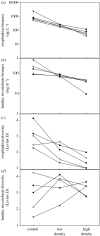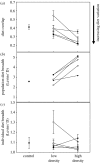Intraspecific competition drives increased resource use diversity within a natural population
- PMID: 17251094
- PMCID: PMC2093969
- DOI: 10.1098/rspb.2006.0198
Intraspecific competition drives increased resource use diversity within a natural population
Abstract
Resource competition is thought to play a major role in driving evolutionary diversification. For instance, in ecological character displacement, coexisting species evolve to use different resources, reducing the effects of interspecific competition. It is thought that a similar diversifying effect might occur in response to competition among members of a single species. Individuals may mitigate the effects of intraspecific competition by switching to use alternative resources not used by conspecific competitors. This diversification is the driving force in some models of sympatric speciation, but has not been demonstrated in natural populations. Here, we present experimental evidence confirming that competition drives ecological diversification within natural populations. We manipulated population density of three-spine sticklebacks (Gasterosteus aculeatus) in enclosures in a natural lake. Increased population density led to reduced prey availability, causing individuals to add alternative prey types to their diet. Since phenotypically different individuals added different alternative prey, diet variation among individuals increased relative to low-density control enclosures. Competition also increased the diet-morphology correlations, so that the frequency-dependent interactions were stronger in high competition. These results not only confirm that resource competition promotes niche variation within populations, but also show that this increased diversity can arise via behavioural plasticity alone, without the evolutionary changes commonly assumed by theory.
Figures




References
-
- Ackermann M, Doebeli M. Evolution of niche width and adaptive diversification. Evolution. 2004;58:2599–2612. doi:10.1554/04-244 - DOI - PubMed
-
- Ali M, Wootton R.J. Correlates of growth in juvenile three-spined sticklebacks: potential predictors of growth rates in natural populations. Ecol. Freshwat. Fish. 2003;12:87–92. doi:10.1034/j.1600-0633.2003.00003.x - DOI
-
- Arau´jo, M. S., Bolnick, D. I., Machado, G., Giaretta, A. A. & Reis, S.F. In press. Using d13C stable isotopes to quantify individual-level diet variation. Oecologia - PubMed
-
- Bolnick D.I. Intraspecific competition favours niche width expansion in Drosophila melanogaster. Nature. 2001;410:463–466. doi:10.1038/35068555 - DOI - PubMed
-
- Bolnick D.I. Can intraspecific competition drive disruptive selection? An experimental test in natural populations of sticklebacks. Evolution. 2004;87:608–618. doi:10.1554/03-326 - DOI - PubMed
Publication types
MeSH terms
LinkOut - more resources
Full Text Sources

